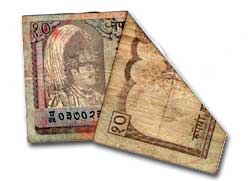 The next batch of crisp new Rs 10 notes coming into circulation next Dasai could be different that the paper notes Nepalis are used to. Nepal Rastra Bank has decided to try out polymer to replace paper money, because it is more durable and cost effective even though it is more expensive to print.
The next batch of crisp new Rs 10 notes coming into circulation next Dasai could be different that the paper notes Nepalis are used to. Nepal Rastra Bank has decided to try out polymer to replace paper money, because it is more durable and cost effective even though it is more expensive to print. "We're ready to try using plastic notes," Upendra Keshari Poudel, executive director, at the central bank told us this week. "Actual tendering will begin after the plan is cleared by government."
One legal obstacle that had prevented the bank from making up its mind earlier was a clause in the law that categorically said money had to be made from "paper". This clause has now been amended in the Rastra Bank rules earlier this year.
The polymer notes don't crumple or rip, they are water and sweat resistant and therefore last longer. And because they don't get soiled easily, they are also germ free. The notes are already in use in countries like Bangladesh, China, Thailand and Indonesia, and in Australia which is the world leader in polymer bank note printing. Australia cash is 100 percent polymer, while the 10 Taka in Bangladesh, 50 Baht in Thailand and the 100-Yuan in China which are the notes in widest ciruclation.
The most used denominations in Nepal are the ones, tens, hundreds and thousands. The NRB has decided not to print more of the ones and go for coins instead. Polymer is being discussed as a option for the tenner. Because the volumes of the 100s and 1000s are not as high, they may continue using good old paper. On average a 10-rupee note lasts 3-6 months and the life span of the polymer (about four years) is what has made it an attractive option. Every year, Nepal prints about 20m pieces of new Rs 10 notes.
 Note Printing Australia (NPA), a subsidiary of the Australian Reserve Bank, had been trying to convince NRB officials to switch to plastic (see: NT #54 left). NPA claims the polymer notes are not just durable and wear-proof (the average life span of a polymer Australian $10 bill is 32 months, compared to its paper life of eight months) but also of enhanced security features-generally used for notes of higher denominations, in addition to all security features paper printing allows.
Note Printing Australia (NPA), a subsidiary of the Australian Reserve Bank, had been trying to convince NRB officials to switch to plastic (see: NT #54 left). NPA claims the polymer notes are not just durable and wear-proof (the average life span of a polymer Australian $10 bill is 32 months, compared to its paper life of eight months) but also of enhanced security features-generally used for notes of higher denominations, in addition to all security features paper printing allows. But polymer money has a flip side: they don't fold easily and counting by hand-as is the practice at the central bank-is not easy. The Nepali practice of stapling notes could be where the Achille's heel for plastic money because the holes would make it tear. The cost of printing new notes is the other short-term disadvantage-it costs two to three times more than paper printing. But Rastra Bank is convinced polymer money is a good investment. It spends about Rs100 million on note printing every year and introduction of plastic would also mean spending less on printing other notes, and displacing established printers. There could be much haggling to that end because notes not printed would also mean someone somewhere would earn less, both legally and underhand.


